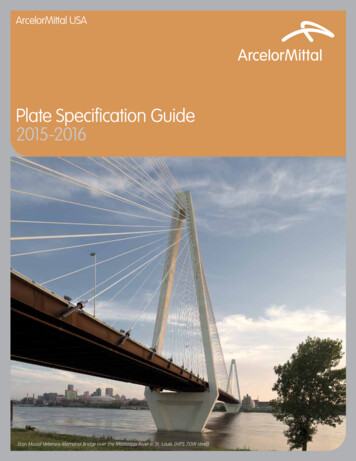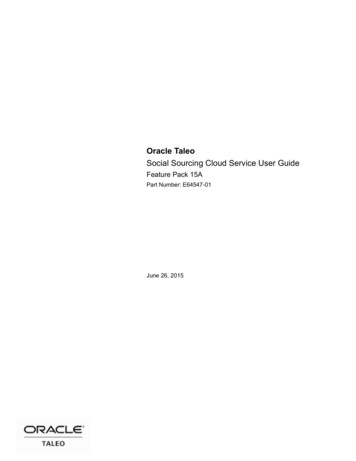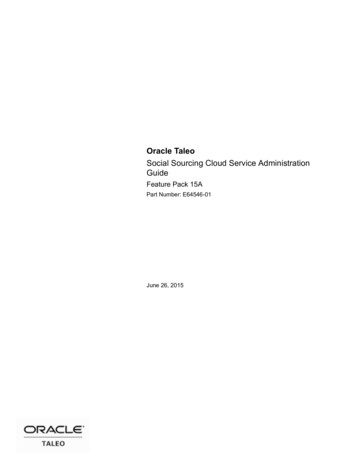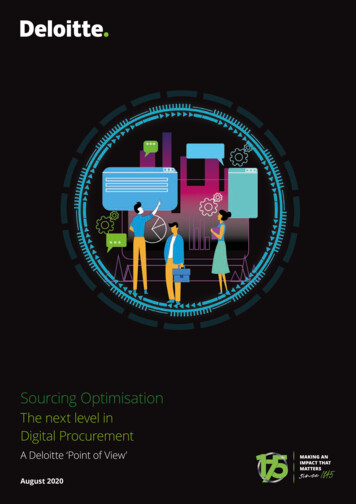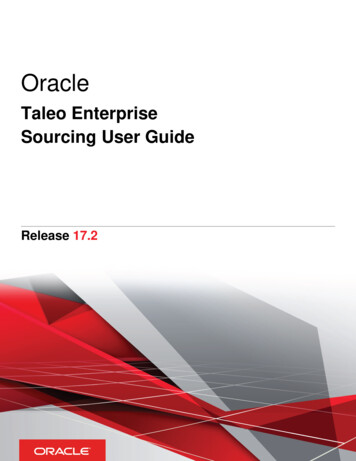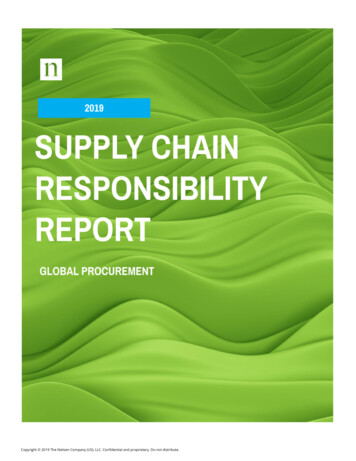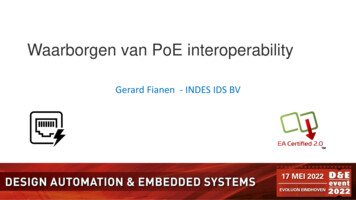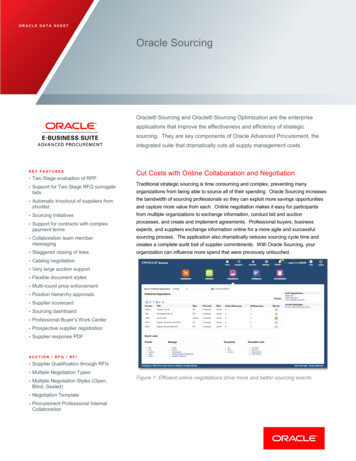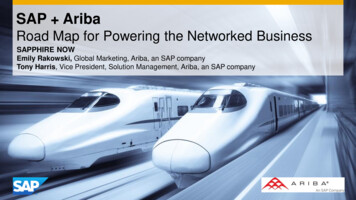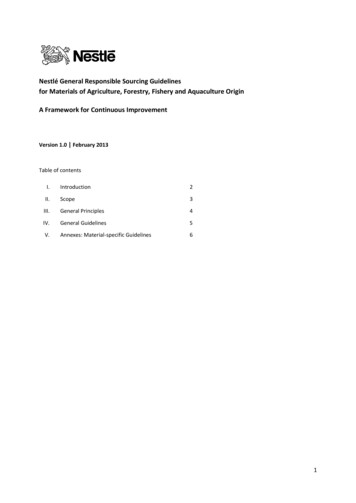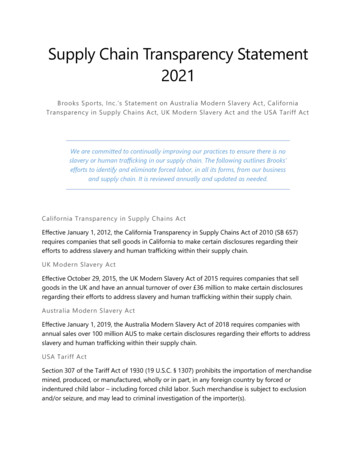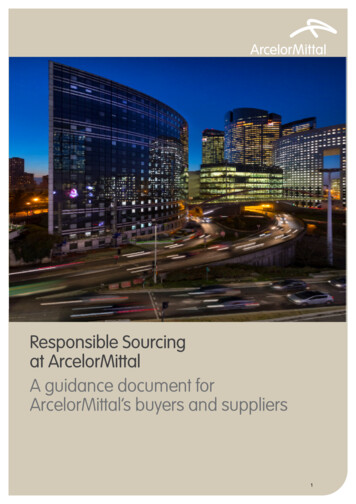
Transcription
Responsible Sourcingat ArcelorMittalA guidance document forArcelorMittal’s buyers and suppliers1
Responsible Sourcing guideContentWelcome ---------------------------------- 3Responsible Sourcing at ArcelorMittal ----------- 4How we will work with our suppliers ------------ 4ArcelorMittal’s Responsible Sourcing process - ---- 5What we expect from our buyers -------------- 6What we expect from our suppliers ------------- 7What the Code requires ---------------------- 81 Health & Safety ------------------------ 892 Human Rights -------------------------3 Ethics -------------------------------- 104 Environmental stewardship --------------- 11Summary --------------------------------- 12Further information ------------------------ 132
Responsible Sourcing guideWelcomeArcelorMittal is the world’s leading steel and mining company, and our goal is to help build a better world with smarter steels.Steels made using innovative processes which use less energy, emit significantly less carbon and reduce costs. Steels thatare cleaner, stronger and reusable. Steels that will support societies as they transform through this century. In line withthis, ensuring that the raw materials, products and parts we use in our production processes are sourced and producedresponsibly is essential.Of all the stakeholders we work in partnership with, one of the most important in achieving our goal and supporting ourcommitment to sustainability are our suppliers. For this partnership to be successful we need to continue building trust, andthat can only come with transparency and good communication.Responsible Sourcing is a key element contributing to this partnership. Our strategy to achieve this is laid out over thenext few pages. This includes a definition of responsible sourcing and specific information about our responsible sourcingstandards and how we are embedding responsible sourcing into our business processes.With the growing importance of sustainability, responsible production and high ethical business standards, we want ourstakeholders to have a full confidence in their choices and to offer them full supply chain reassurance. This is why we arecommitted to the ResponsibleSteel standard, the steel industry’s first global multi-stakeholder standard and certificationinitiative. We believe that standards, auditing and accreditation are essential to meeting sustainability expectations and themulti-stakeholder aspect is integral to ensuring the standard is robust and credible. This is why, specifically regarding rawmaterials, our vision is to source from suppliers whose location is known and whose policies and practices are aligned to theResponsibleSteel standard. More information on this can be found in the Code and this guide.We ask all our suppliers to formally commit to meeting the requirements set out in our Code for Responsible Sourcing. TheCode is supporting the company’s 10 sustainable development outcomes – which are aligned with the 17 UN SustainableDevelopment Goals and describe the business we need to become to bring optimal value to all our stakeholders – to driveour transformation into the steel company of the future. (add a link to the 10SD outcomes on the website).We hope you will find this guide clear and useful to explain what we mean by Responsible Sourcing, and how together we canmake this happen.The full text of the Code for Responsible Sourcing is at the back of this document, with the first pages clearly laying outwhat this means in practice for both you, and us, in achieving Responsible Sourcing.Nicola DavidsonHead of Corporate Communication & Corporate ResponsibilityApril 20213
Responsible Sourcing guideResponsible Sourcing at ArcelorMittalFor ArcelorMittal, Responsible Sourcing is about ensuringthat we have access to the goods and services that ourplants need, which are sourced and produced responsiblyand comply with the social, environmental and governancestandards (specifically health and safety, human rights,ethical and environmental standards) set out below. Thisapproach covers everything from the components usedin the goods and services, to the working conditions ofthe people producing them. It includes the supplier’senvironmental performance, its business practices, and howand where it sources its raw materials.Responsible sourcing with social, environmental andgovernance standards in mind not only minimises negativeimpacts, but helps to raise standards in key areas likeworking conditions and Health & Safety, as well asimproving business climate overall. It is also commerciallyadvantageous; greater efficiency and less waste leads tolower risk and costs for everyone involved along the valuechain.At ArcelorMittal, we have been making progress in allareas of Responsible Sourcing over the last few years, andhave formalised our principles and policies into one overallprogramme that is aligned with our purchasing qualitymanagement system.We apply the same principles and standards wherever we arein the world and whatever the category of spend.Our objectives are to work with our suppliers to:1) Operate a lean supply chain that supports our corporateresponsibility policies.2) Develop sourcing solutions in line with customer,regulatory and wider stakeholder needs and expectations3) Create long-term value and reduce risk for our business,our suppliers, our customers and other stakeholders.How we will work with our suppliersWe seek to develop collaborative relationships withsuppliers. We encourage our suppliers to work with us toidentify and develop ongoing performance improvementsto our responsible sourcing programme. We hope that thisCode will promote sustainable business practices by oursuppliers.To support suppliers, we will:CollaborateWork with suppliers to improve responsible businesspractices in the areas of social, governance andenvironmental standards, specifically in health and safety,human rights, ethics and environmental standards.This may include joint assessments, such as site visits, toevaluate performance against the Code. We will also shareour knowledge about independent certification schemes andassist our raw material suppliers in achieving the standard.SupportHelp suppliers to identify activities that fall below therequirements of the Code and work towards achievingimproved conditions in a timely manner.PrioritiseWe will be focusing our efforts on the parts of our supplychain which pose the greatest risk, and where improvementswill make the most impact.RespectJust as we expect fair, open and objective practices from oursuppliers, we will behave in the same way.PromoteWe will act as an advocate for responsible supply chainpractices within our industry, sharing good practices withothers.The Company is committed to the ResponsibleSteel standard, the steel industry’s first global multi-stakeholderstandard and certification initiative. Therefore, specificallyregarding raw materials, ArcelorMittal’s vision is to sourcefrom suppliers whose location is known and whose policiesand practices are aligned with the ResponsibleSteel standard. This means working towards certificationschemes which have developed robust environmental,social and governance standards (ESG) in partnership withstakeholders, and which operate site specific certificationschemes against that standard. The Initiative for ResponsibleMining Assurance (IRMA) or Towards Sustainable Mining(TSM) are good examples of this.Buying raw materials from independently certified mineswill bring our supply chain in line with the ResponsibleSteel certification. We are encouraging our raw material suppliersto follow one of the certifications routes.Communicate and trainWe will provide training to all our employees responsible forpurchasing.ImproveJust as we expect continuous improvement from oursuppliers, we will apply the same criterion to our ownperformance.4
Responsible Sourcing guideArcelorMittal’s Responsible Sourcing processDeveloping a sourcing strategy:Before looking for a supplier for a service or product, all ArcelorMittal buyers need to work through the following questionswith the internal user:1Is there anopportunitynot to buy thisproduct at all?For example,could thedepartment reuse somethingelse, or dowithout?2Have there beenany technologicaladvances relatedto this productthat would fitbetter with ourResponsibleSourcingobjectives?34Can thedepartmentdo anythingto minimisethe amountof transportrequired todeliver theproduct?5Can the supplierdo anything tominimise theenergy or wateruse required tomake or run theproduct?Can the suppliertake back allthe packagingand recycle theproduct at theend of its life?6Is the supplier committedto sourcing and producingresponsibly and can provideevidence? Is the suppliers’ ESG’sstandards embedded into itsbusiness practices?For raw material suppliers: isthe supplier committed to anindependent multi-stakeholdercertification?Factor identified opportunities into the Request for Proposal.New supplier approvalNew tenders with existing suppliersAll new suppliers are required to sign up to the Code as part of the new supplierqualification process. Additional requirements for health and safety are includedfor all Requests for Proposal/contracts for high risk activities (e.g. constructionand maintenance).A risk assessment is carried out to identify high risk new suppliers. This is based onfactors such as: potential spend, nature of product or service, country of origin.For suppliers identified as high risk, buyers will assess Responsible Sourcing criteriaas well as commercial factors such as price and quality. This may require site visitsin some cases, and some suppliers may only be given only provisional approval,until their performance in this area can be properly assessed.The Code for Responsible Sourcing is included in all our tenders.A risk assessment is carried out to identify high risk new suppliers. This is based on factors such as: potential spend, natureof product or service, country of origin.For those suppliers identified as high risk, suppliers’ performance will be are assessed against Responsible Sourcing criteria, and ArcelorMittal buyers do request a detailed plan for anyareas that need improvement.CONTACT APPROVALRegular evaluations are carried outfor our key suppliers. ResponsibleSourcing questions are included inthese assessments.plier evaluatioSupnprojectstionnosmvasesRi s k A snteAs part of the ongoing purchasingrisk assessment, risks related toResponsible Sourcing are reviewed andappropriate mitigation plans eup prinOur goal is to keep developing specialprojects in specific high-priority areassuch as Health and Safety, the useof technology, energy efficiency andrecycling. The aim in each case is togenerate business benefits, as well asenvironmental and social benefits, forthe community providing the goodsand services.5
Responsible Sourcing guideWhat we expect from our purchasing teamsOur Code for Responsible Sourcing (“Code”) is designed toraise environmental and social performance across our wholesupply chain.Whilst some of our suppliers are already meeting standardswithin the Code for Responsible Sourcing, others will needto improve their performance to do that. We are lookingfor a long-term commitment to our Responsible Sourcinggoals, and we will work actively with any suppliers who don’tcurrently meet our standards to help them improve. Ourobjective is to make progress in partnership for a greateroverall goal.Key action points for buyers: Distribute the Code to all suppliers when required. Ask all your suppliers to sign up to the Code and committo meeting its requirements. Ensure that a link to the Codeis present in all contractual documents issued. Promote ArcelorMittal’ s commitments to theResponsibleSteel standard, the steel industry’s first globalmulti-stakeholder standard and certification initiative.What happens if a supplier refuses to commit to theCode for Responsible Sourcing?The Code reflects good practices in the areas ofenvironmental, social and governance standards, specificallyin health and safety, human rights, ethics and environmentalstandards, based on common and widely accepted businesspractices.We acknowledge that some of our suppliers may not be ableto meet all the requirements of the Code straight away. Thismay be acceptable as long as the supplier can commit toimplement an agreed action plan over a reasonable period oftime.If a supplier refuses to make a commitment to meet thesestandards, we will seriously consider whether this is asupplier we can do business with. However, this decision willonly be made as a last resort.Developing a sourcing strategyThe Code is fully integrated with the way we manageprocurement, which means it is part of the process from theoutset. This process should always start with a conversationbetween you and the user of the goods or service. You needto ask them a number of important questions about theproduct or service the department needs to buy in order todetermine the best way forward.For example: Can the purchase of this product be avoided? For example,could the department re-use something else, or dowithout? Have there been any technological advances related tothis product that would fit better with our ResponsibleSourcing objectives? Can the department do anything to minimise the amountof transport required to deliver the product? Can the supplier do anything to minimise the energy orwater use required to make or run the product? Can the supplier take back all the packaging and recyclethe product at the end of its life? Is the supplier committed to sourcing and producingresponsibly and can provide relevant evidence? Is the supplier’s ESG standards embedded into its businesspractices? For raw material suppliers: Is the supplier committed to anindependent multi-stakeholder certification? Once you and the ArcelorMittal department have answersto these questions, the next step is supplier approval.New supplier approvalYou must include Responsible Sourcing criteria when you areconsidering a new supplier, as well as commercial factorssuch as price and quality. This may require site visits, and youmay have to grant some suppliers provisional approval onlyuntil their performance in this area can be properly assessedfollowing a trial. Through the qualification process all newsuppliers will be asked to sign up to the Code.TenderingThe Code is included in all our tenders for existing suppliersand the signing of the Code will be confirmed as part ofthe tender evaluation. Taking a risk-based approach, thesuppliers’ performance against the Code will have to belooked at, and a detailed plan will be requested for any areasthat need improvement.What do we mean by a risk-based approach?It is not feasible to actively consider each supplier’sperformance against our Code. We will prioritise ourapproach to selectively engage with our suppliers, and focusattention on those parts of the supply chain, or the Code,where the risk is highest.Performance managementAnnual supplier evaluations will be carried out. Taking a riskbased approach, key topics of the Code are included in theassessment questionnaire. Where there are areas that needimprovement, an improvement plan will be jointly set upwith suppliers. Improvement will then be monitored till fullcompletion.Risk managementWe see a more responsible approach to sourcing as animportant way of reducing procurement risk. It gives us6
Responsible Sourcing guidea much broader perspective that goes beyond supplydisruptions or price volatility and helps us focus on suppliersin categories that might pose higher risks.Key action point for buyersEnsure Responsible sourcing is integrated throughout thewhole procurement process, starting with the sourcingstrategy and the Request for Proposal. All contractualdocuments (contracts, purchasing orders) are to also referto the Code and our desire for all ArcelorMittal suppliers toconfirm their commitment to the Code.As a buyer you are supported by:TrainingOnline training will be made available. This will give ourprocurement teams the background to Responsible Sourcing,as well as what it means for ArcelorMittal, and what ourprocurement teams are required to do.Key action point for buyersShare good ideas and best practice with your suppliers.Innovation in Responsible SourcingWe are consistently looking for innovative projects inspecific high-priority areas. Projects cover areas such asthe use of technology, energy efficiency, and recycling. Theaim in each case is to generate business benefits, as wellas environmental and social benefits for the communitiesproviding the goods and services.What we expect from our suppliersThe Code for Responsible Sourcing applies to all our suppliersand contractors, as well as anyone working on our behalf.The Code covers all the goods and services we buy, fromraw materials to professional services, in every marketwhere we operate across the world. We expect all oursuppliers to commit to meeting these requirements, andwe will ask you to acknowledge it through either thequalification or evaluation processes or random requests.We won’t expect you to meet all the requirements fromday one, but we will expect a commitment to doing so overa reasonable period of time. We will work with you to helpyou do this, whether by offering help in specific areas, orby giving you access to examples of best practice fromelsewhere in our supply chain.If you are a new supplier to ArcelorMittal, we will ask you tocomplete a self-assessment questionnaire, or co-operatewith us in a site audit, as part of the qualification phase. Wemay also ask the same from existing suppliers, though thiswill depend on the nature of their operation or the goods wesupply and whether we consider these to be high risk.Key action points for suppliers: Read the Code and sign the acknowledgement that youcommit to meet its requirements. Ensure that your company can meet the requirements andtake the necessary steps to close any gaps. Talk to your ArcelorMittal buyer about the action you aretaking and ask for help if you need it. Complete any self-assessment questionnaires you aresent before qualification, or during the supplier evaluationprocess, giving evidence to back up your replies whenrequested. Look for ways to continuously improve your performancein the future. Share good ideas and learning points with yourArcelorMittal buyer, so we can share best practice morewidely. Promote the principles of the Code for ResponsibleSourcing in your own supply chain. Sensitise your own buyers and stakeholders about theResponsibleSteel standard, the steel industry’s first globalmulti-stakeholder standard and certification initiative.Your designated buyer will work with you on all aspects ofyour relationship with ArcelorMittal, including ResponsibleSourcing. They will review any questionnaires we ask you tocomplete, and work with you to develop a plan to addressany issues that emerge.7
Responsible Sourcing guideWhat the Code requiresThere are four key areas under the Code.These are:1 Health & Safety2 Human rights3 Ethics4 Environmental stewardshipSome of these issues will significantly vary fromindustry to industry, and the potential risks willdepend on the nature and origin of the goods andservices supplied. What we have provided on thefollowing pages are the ‘headlines’ of each of thesefour parts of the Code, with examples of what wewould expect under each.A copy of the Code for Responsible Sourcing isprovided at the back of this document.1 Health & SafetyThis is the number one priority for ArcelorMittal.Our target is a zero-accident rate, both forour own employees and our contractors. Asan ArcelorMittal supplier, we expect you to beworking towards the same goal.If you’re a contractor working at one of our sites you willneed to meet certain specific Health & Safety requirements.Your local site can provide further information. We expect allour suppliers to:Identify, evaluate and eliminate Health & Safety risksWe see this as the basis for any well-managed workingenvironment. It includes identifying potential hazards,assessing who might be harmed, evaluating the risks,developing mitigating actions and regularly reviewing yourassessment. We also expect you to have your own Health& Safety policy and management system, ideally one thatconforms to the international Health and Safety Standard,OHSAS 18001:2007.Establish an effective process for preventing injuries andwork-related illnessesBuilding on the health and safety risk assessment and healthand safety management system, our suppliers should makesure they have effective preventative processes in place.This may include, for example, providing workers withappropriate personal protective equipment and carrying outannual employee health checks.Ensure there is visible leadership and clear accountabilityon everything relating to Health & SafetyEffective health and safety performance comes from thetop; members of the most senior leadership have bothcollective and individual responsibility for health and safety.Directors and boards need to examine their own behaviours,both individually and collectively, against the guidance given.If they fall short of this standard, it is their responsibility tomake the required adjustments to achieve more effectiveleadership in health and safety.Give everyone effective trainingEveryone who works for you needs to know how to worksafely and without risks to health. Provide clear instructions,information and adequate training for your employees,including contractors. Everyone must has information on: Hazards and risks they may face Measures in place to deal with those hazards and risks How to follow any emergency proceduresYou should also keep records of all personnel who have beentrained, and when.Investigate all incidents and near-hits to prevent futurerecurrencesIn our experience, the best way to avoid accidents is to learnfrom previous instances and near-hits.Establish objectives and monitor progress throughregular audits and reportingYou should consider a combination of leading and laggingindicators. For example, leading indicators might includenear-hits, and the most important lagging ones would beLost Time Injury Frequency, and other similar measures suchas total recordable cases.Comply fully with all legal requirementsUpdate and test emergency response proceduresWe expect all our suppliers to have written emergencyresponse procedures, well-maintained fire alarms, andregular evacuation drills.Observe good health managementThis includes everything from providing clean drinking waterand suitable toilet and washing facilities, to employee wellbeing programmes. These might cover subjects such as dietand nutrition, healthy lifestyles, and stress management.8
Responsible Sourcing guide2 Human rightsIn 2011, ArcelorMittal was the first company inthe steel industry to have a standalone humanrights policy. This policy is based on the UnitedNations Declaration on Human Rights and theInternational Labour Organisation’s Declaration ofFundamental Principles and Rights at Work.Here are the headline requirements under this part of theCode, with an explanation of what is meant by each.In practice, we require our suppliers to meet the highestapplicable standards, whether that is our Code or theirown local laws and regulations. Some parts of our Codeare aligned to Social Accountability International’s SA 8000standard. If you are already certified under that standard youwill already be meeting many of our requirements.As before, there will be specific risk areas that are morerelevant for certain suppliers, but at a minimum we expectall our suppliers to:Promote ‘freedom of association’This means respecting the rights of employees to set upgroups or trades unions to promote their rights at work andbargain collectively. In countries where only state-authorisedorganisations are allowed, we expect our suppliers to makeit easy for employees to gather together to discuss workrelated matters and raise these with management.Eliminate forced or compulsory labourThis means ensuring that no-one is forced to work underany kind of threat. In practice, this covers issues like allowingpeople to end their employment voluntarily and withoutany kind of penalty, and giving everyone clear contracts ofemployment that cover rights, obligations, notice periodsand grievance procedures. Likewise, any loans to employeesshould not be part of their contract and should be coveredby a legal agreement.Abolish child labourUsing guidelines from the International Labour Organisation,a child labourer is a child under 14 years of age involved inregular work. This applies for those under 15 in developedcountries. Child labour is often defined as work that depriveschildren of their childhood, their potential, their schoolingand their dignity, and is harmful to their physical and mentaldevelopment (like heavy, nightly or dangerous work). Weexpect our suppliers to ensure that they only employ peopleabove the set age, and to take care that children under 18years of age are never employed for hazardous work.Eliminate unlawful discrimination in the workplaceThis means treating everyone equally and fairly, regardlessof their age, sexuality, race, gender, religion, or disability. Weexpect our suppliers to have written policies covering this,and to train their Human Resources personnel on how toapply them.Eradicate harassment and violenceThis means making sure no-one has to face verbal orphysical abuse at work, or any kind of behaviour that createsa hostile or intimidating atmosphere. Sexual harassmentis part of this. We expect all our suppliers to have policiesin place to deal with this, and appropriate training formanagers.Offer competitive compensation and remunerationThis means making sure that wages are appropriate for thekind of work being done and the experience of the worker.Wage levels should also take local factors into account, suchas inflation levels.Uphold fair conditions of employmentThis means complying with all relevant employment laws,especially in relation to working hours, overtime and breaks.Respect indigenous peoples’ rights and avoid involuntaryresettlementsIndigenous Peoples are distinct communities whose uniqueidentity and culture is inextricably linked to the land on whichthey live, and the natural resources on which they depend.The most obvious way in which we respect the rights ofthese peoples is by avoiding moving them from establishedsettlements to make way for business operations. Weexpect our suppliers to do the same. Where this is genuinelyunavoidable, the process must be handled with the utmostsensitivity, and according to local government guidelines,and international best practice in human rights.Adopt appropriate security arrangementsArcelorMittal applies security standards which are consistentwith the Voluntary Principles on Security and Human Rights.These give guidance on the best ways for mining and otherextractive industries to ensure the safety of their sites andpersonnel. The Principles apply to both our own securitystaff and the third-party security firms we work with andcover how these people interact with public security forces.We expect our suppliers to follow these Principles whereverappropriate.Develop sound practices in relation to land and water useThis is covered in detail in the Environmental stewardshipsection.9
Responsible Sourcing guide3 EthicsWe are committed to fair and open businesspractices. This applies to our purchasing practicesin general, as well as specific areas related to oursector. For example, we will only use raw materialsthat we can verify have come from a legal andsustainable origin and we will not source ‘conflictminerals’.Key aspects of our approach to ethical business practice areincluded in our overall Code of Business Conduct, AntiCorruption policy, Conflict Minerals Procedure and newguidelines on Economic Sanctions. You can read these in fullat orategovernance/compliance-and-policiesSome of the key requirements under this part of theResponsible Sourcing Code, with some examples of whatthis might mean in practice, are listed below. We expect oursuppliers to:Have clear governance, monitoring, and internal controlsto ensure ethical business practices.You should have a company-wide code of conduct, includingmeasures to eliminate corruption and address potentialconflicts of interest, as well as an appropriate whistleblowing procedure.We expect our suppliers to have a board level committeewho is responsible for ethics, as well as robust processesfor managing and monitoring ethical risks alongside allother operational risks your business might face. Forexample, suppliers should have a clear policy and processfor managing conflict of interests stemming from theiremployee’s interests in their supply base.Give everyone effective trainingWe expect our suppliers to offer training to all theiremployees on ethical business practices, and how to reportsuspected non-compliances. It is helpful to include ethicaldilemmas as part of this training. Employees should alsoacknowledge understanding of, and compliant with, with thecode of conduct following this training.Demonstrate accountabilityWe also look for leadership from the top: your Chairman,CEO and senior team should actively endorse and exemplifygood ethical practice.For suppliers in the extractives sector, suppliers shouldconsider taking part in initiatives such as the ExtractiveIndustries Transparency Initiative, and we encourage allsuppliers in every sector to consider participating in the UNGlobal Compact Anti-Corruption working group and theWorld Economic Forum – Partnering Against CorruptionInitiative.Raw Material suppliers are encouraged to source fromsuppliers whose policies and practice are with theResponsibleSteel (insert li
ria, and ArcelorMittal buyers do request a detailed plan for any areas that need improvement. CONTACT APPROVAL Ongoing supplier relationship management S u p p l i er v a u a t i o n S u p p l i e r Responsible Sourcing are reviewed and i n n o v a t i o n k p r o j e c t s R i s A s s e s s m e n t As part of the ongoing purchasing risk .
